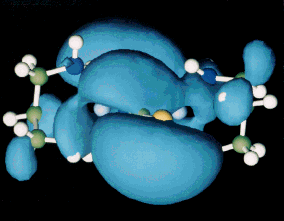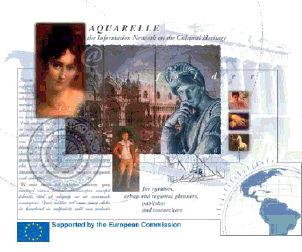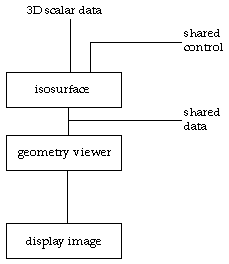


NOTE: many of the urls referenced in this newsletter are no longer active.
We are delighted that a major new project in computational chemistry is using the supercomputing resources at RAL, CLRC. EPSRC has provided funding for the establishment of a Facility for Computational Chemistry in the United Kingdom, for four years with effect from January 1997. The grant provides a large (at least 16000 cpu hours per year) amount of computing time on the DEC 8400 (Columbus), a substantial sum for the purchase of computational chemistry software, which will be maintained on the Facility, and support for a software expert whose duty includes the acquisition, maintenance and the provision of expert advice on the software, as well as the overseeing of the day-to-day operation of the Facility.

The provision has been made in the form of a Research Grant with Professor N C Handy as the Principal Investigator and Dr J Gerratt, Professor J M Hutson, Professor M A Robb and Dr R A Jackson as co-investigators. Dr Julie Altmann has been appointed as the software expert and the administration for the Facility is being provided by King's College, London.
All UK scientists who wish to use the computational chemistry software on Columbus are invited to apply for time on this Facility. It is anticipated that the entire spectrum of computational chemistry will be represented by software on the Facility. Although it is still possible to apply for time on Columbus through regular EPSRC channels, the UK Computational Chemistry Working Party anticipates that most scientists working in this field will wish to apply for time, because they will then be able to take advice from the software expert. Current Columbus users accessing the chemistry software are also encouraged to join the Working Party so that they may benefit from the expert software support.
Further information on the Facility is available from: Dr J A Altmann, Department of Chemistry, King's College London.
An expanded version of this article is available on the EPSRC Web site: http://www.epsrc.ac.uk/hpc/chemistry/ccwp.html
Access to the cultural heritage of Europe is |the theme of the Aquarelle project, within the European Commission's Telematics Applications Programme. Many museums, art galleries, and other cultural organisations have independently set up databases to record details of their collections but these are often only accessible locally and via their own particular interface. The rapidly increasing spread of the Internet and the adoption of World Wide Web (WWW) type technologies give the opportunity for wider access to this valuable data through a uniform interface.
The Aquarelle project seeks to exploit this opportunity by providing a system that will give uniform access to this varied collection of data. Further, it aims to make available other information about the collections, or the items within them, that may not currently be in digital form.

This other information is the result of the work of the curator or custodian of the collection and will often be found in manilla folders. It will include such items as specialist (curatorial) knowledge related to the collections, information about the existence or location of related items, or simply physical details of the size and materials of the items to aid in their conservation and storage. Since this information will also point to other information (details of the living conditions in a particular period, letters from a sculptor, images of paintings by the same artist, conservation details for particular materials), it has a natural representation within a hypermedia structure.
The project has developed the concept of a folder to hold this additional information. Folders will be stored as SGML documents and may contain links to other folders or to collections' data (in archives). In order to improve the integrity of the links over those found elsewhere on the WWW, a link server will be provided to maintain persistent links that will be much less vulnerable to deletion or change of location of target information. Folders will be located using the same uniform interface used to access the archive data.
The Aquarelle system is based around the concept of an access server on which users will be registered and which will provide a uniform interface to the data servers (archive and folder servers), using the standard search and retrieve protocol Z39.50. Users will communicate with the access server via a user client which will be based on a WWW browser with a set of tailored forms to select target data servers, consult a thesaurus, translate terms between languages, compose queries, retrieve result summaries and full details, and browse folders. Several targets may be addressed at the same time with the same query (translated to a different language where necessary). There are provisions for the access server to be distributed to make the system scalable to large numbers of data servers and users; users and data servers will be registered on particular access servers and the access servers will be linked to allow access to all the information by a particular user.
As access will be restricted to registered users, it will be possible to control access rights of individuals and will provide the opportunity to charge for information which has a commercial value, although this will require further development work. It will also be possible to watermark images so that their source can be traced if they are misused.
A prototype system is under construction and will undergo trial usage later this year. Following feedback from the users, the full system will be constructed and undergo full-scale user evaluation in 1998.
Although access to cultural heritage is the motivation for the current project, the ideas embodied within it could be applied to other areas leading to a system with much wider applicability. CLRC's DCI is one of the 23 organisations participating in the project, which is managed by the European Research Consortium for Informatics and Mathematics (ERCIM). As might be expected, the Aquarelle consortium includes the Ministries of Culture of France, Italy and Greece (as well as the Royal Commission on Historical Monuments in England), museums, and picture libraries, as users / information providers, and commercial and research organisations from the four countries, as technical partners.
Co-operation between scientific groups is vital in many fields of research. Ideas are shared and the strength of hypotheses can be tested. Moreover the increasing dominance of large scale experimental data and computer analysis in scientific work means that the subject of much co-operation is often the data. Although this is assisted by existing Internet tools such as e-mail, WWW and file transfers, more intensive co-operation takes place when groups meet.
So it is interesting to ask the question; what aspects of a scientific meeting can be captured over a computer network and does providing them allow effective meetings to be held? There are three main issues that one may wish to attempt to capture and distil out to a few main ideas:

The Multimedia and network in cooperative research and learning (MANICORAL) project of the European Union (EU) involves partners from 3 main disciplines:
MANICORAL aims to address the problems of networked scientific meetings by pursuing the following objectives:
Communicating speech and video is already well studied. MANICORAL is using the Mbone tools provided by the EU MERCI project, through University College, London.
DCV will encourage sharing of tasks in several ways:
In order to gain experience of co-operative working at a range of network bandwidths and loadings, MANICORAL will take part in the EU's JAMES network which uses ATM technology to gain high bandwidth and is available for use by EU Telematics projects.
The DCV system will be evaluated by the scientists in the project during the last half of 1997.
As previously announced in ATLAS (Issue 5) the Department for Computation and Information will be participating in a project to run a Usenet news service for the UK academic community administered by UKERNA. CLRC will host two of the news servers, one located at Rutherford Appleton Laboratory and the other at Daresbury Laboratory.
These two machines will form part of a network of news servers that have been distributed strategically throughout the UK to optimise the transfer of news to the community.
The project commenced at the beginning of March 1997 with a 6 month pilot. During the pilot the hardware, software and news system are to be installed and tested. Towards the end of the period Janet sites will be invited to participate in trials of newsfeeds from this service.
The new service has been designed to provide as much resilience as possible. For example, each peer site (those forming the Usenet backbone) will have a different Internet Service Provider. Each peer site will also provide a primary backup for another in the backbone. In addition, each client site (those receiving a newsfeed) will be allocated a primary and secondary newsfeed to protect the flow of news to the site.
Further details on the progress of this project and details of how to subscribe will be provided in a later ATLAS issue.
NERC has asked CLRC to procure and operate a new supercomputing service specifically for the environmental modelling community. The requirement has arisen particularly due to the demands for analysis of atmospheric science data in the UGAMP project being beyond the capacity of the NERC share of the Cray J932.
The procurement is targeted at providing substantially more performance than can be obtained from a single J90 processor and the tender document which has appeared in the EU Journal asks for an aggregate performance of around 4 Gflop/sec and a physical memory of at least 2 GBytes. The benchmark for the new machine consists of real applications from the atmospheric, oceanographic and minerological areas.
The NERC supercomputer procurement has decided to purchase a Fujitsu VPP300 machine with three 2.2 Gflop/sec processors and 6 Gbyte of memory and it will soon be available to the NERC research community. An announcements of the new supercomputer will be appearing through the electronic news channels.
We are optimistic that this will be an exciting new development for us and we look forward to providing a powerful supercomputing service to this prestigious user community.